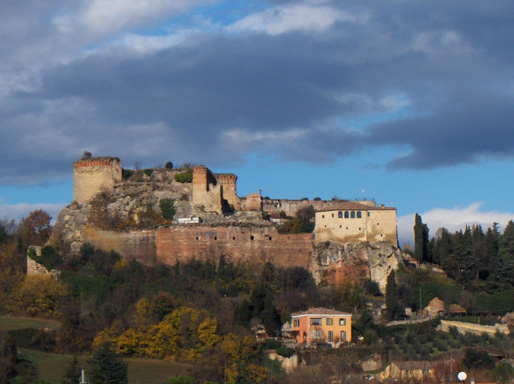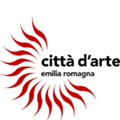Castrocaro Terme
 In the heart of Romagna lies Castrocaro Terme, at 10 km far from Forlì, on the state road 67, connecting Ravenna to Florence: It is famous for spa and tourism.
In the heart of Romagna lies Castrocaro Terme, at 10 km far from Forlì, on the state road 67, connecting Ravenna to Florence: It is famous for spa and tourism.
Castrocaro was already known to the Romans as “Salsubium” (for its salty waters). In the Middle Ages it was given its present name probably originating from the Celtic Kaster Kar (rocky crag) or deriving from Castrum Cari, that is, encampment of Caro or Carino, Roman emperors who reigned during the 3rd century. The town was even quoted by Dante Alighieri in his famous invective against some noble Romagna families.
The history of the town encompasses two distinct periods: the direct and almost uninterrupted rule of the Church until 1403 and then that of Florence until the Unity of Italy, after a short Napoleonic period. Ruled by the Archbishops of Ravenna under the Papal State and by noble families of that time, such as the Ordelaffis and the Manfredis, the town of Castrocaro attempted for short periods to gain independence, but had to seek protection in the Papal state.
Under the Florentines Castrocaro was for a long time the chief town of Tuscan-Romagna provinces. After the construction of the nearby Medici town of Terra del Sole and the transfer of the administrative and judicial offices to the new town, Castrocaro lost in importance until 1830 when Professor Antonio Targioni Tozzetti brought to light the curative properties of the bromoiodide waters of Castrocaro which began to be used for treatment purposes. From that time on the name of Castrocaro is linked to the effectiveness of its thermal treatments.
Also to be seen is the medieval village, with interesting buildings from the Middle Ages and Renaissance period. Worth seeing is the 15th century Palazzo dei Commissari, the dwelling of the Captains of Justice sent by Florence during the time when Castrocaro was the chief town of the province of Tuscan-Romagna; the Fortress (10th-16th century), overlooking the village and housing a museum and a wine shop, is the venue for medieval feasts and falconry shows; the Bell Tower, known as 'è Campanon', the Baptistery of San Giovanni alla Murata at the foot of the fortress, the Entertainment Pavilion in pure art-deco style with beautiful decorations by Tito Chini and the Grand Hotel delle Terme designed by Piacentini and set in the spa park, an example of Fascist architecture during the Twenties; not to miss is a walk along the river park bordering the Montone river. There is also the opportunity to visit the farming businesses and holiday farms being members of the Food and Wine Routel of the hills around Forlì-Cesena
Castrocaro was already known to the Romans as “Salsubium” (for its salty waters). In the Middle Ages it was given its present name probably originating from the Celtic Kaster Kar (rocky crag) or deriving from Castrum Cari, that is, encampment of Caro or Carino, Roman emperors who reigned during the 3rd century. The town was even quoted by Dante Alighieri in his famous invective against some noble Romagna families.
The history of the town encompasses two distinct periods: the direct and almost uninterrupted rule of the Church until 1403 and then that of Florence until the Unity of Italy, after a short Napoleonic period. Ruled by the Archbishops of Ravenna under the Papal State and by noble families of that time, such as the Ordelaffis and the Manfredis, the town of Castrocaro attempted for short periods to gain independence, but had to seek protection in the Papal state. Under the Florentines Castrocaro was for a long time the chief town of Tuscan-Romagna provinces. After the construction of the nearby Medici town of Terra del Sole and the transfer of the administrative and judicial offices to the new town, Castrocaro lost in importance until 1830 when Professor Antonio Targioni Tozzetti brought to light the curative properties of the bromoiodide waters of Castrocaro which began to be used for treatment purposes. From that time on the name of Castrocaro is linked to the effectiveness of its thermal treatments.
Altitude: at sea level
Inhabitants: 6096 inhabitants
Surface: 39 kmq
How to get there
Castrocaro is 10 km far from Forlì on the 67 state road connecting Ravenna to Florence, in the direction of Florence.
It is 14 km far from Forlì airport and 12 km from Forlì train station.
Address: IAT Office - 20/28, Viale Marconi
Telephone number: +39.0543.769631
Fax: +39.769631
Email: iatcastrocaro@visitcastrocaro.it
Sito WEB: www.visitcastrocaro.it
Other news
Also to be seen is the medieval village, with interesting buildings from the Middle Ages and Renaissance period. Worth seeing is the 15th century Palazzo dei Commissari, the dwelling of the Captains of Justice sent by Florence during the time when Castrocaro was the chief town of the province of Tuscan-Romagna; the Fortress (10th-16th century), overlooking the village and housing a museum and a wine shop, is the venue for medieval feasts and falconry shows; the Bell Tower, known as 'è Campanon', the Baptistery of San Giovanni alla Murata at the foot of the fortress, the Entertainment Pavilion in pure art-deco style with beautiful decorations by Tito Chini and the Grand Hotel delle Terme designed by Piacentini and set in the spa park, an example of Fascist architecture during the Twenties; not to miss is a walk along the river park bordering the Montone river. There is also the opportunity to visit the farming businesses and holiday farms being members of the Food and Wine Routel of the hills around Forlì-Cesena.
Cartographic references
Foglio 99 I S.E. "Castrocaro", Foglio 99 II N.E. "Dovadola", Foglio 100 III "Predappio", Foglio 100 IV S.O. "Forlì".
Torna indietro
Comune di Forlì - Piazza Saffi, 8 47121 Forlì
PEC: comune.forli@pec.comune.forli.fc.it - P.Iva: 00606620409
A cura della Redazione di Turismo Forlivese, Piazza Saffi 8, 47121 Forlì - iat@comune.forli.fc.it - Tel. 0543 712362














